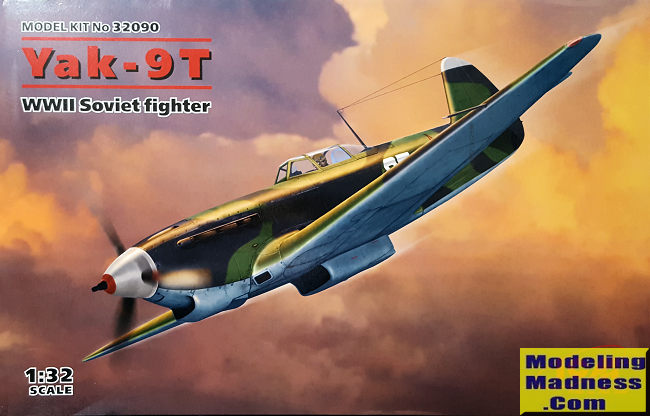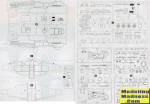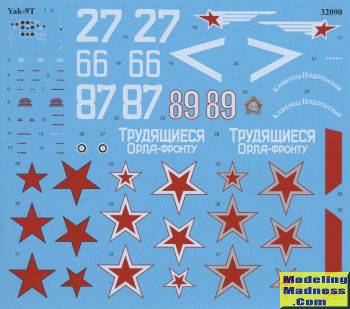
| KIT #: | 32090 |
| PRICE: | $54.99 plus shipping |
| DECALS: | Four options |
| REVIEWER: | Scott Van Aken |
| NOTES: | 2022 New tool kit |

| HISTORY |
The Yakovlev Yak-9 (Russian: Яковлев Як-9) is a single-engine, single-seat multipurpose fighter aircraft used by the Soviet Union and its allies during World War II and the early Cold War. It was a development of the robust and successful Yak-7B fighter, which was based in turn on the tandem-seat advanced trainer known as the Yak-7UTI. The Yak-9 started arriving in Soviet fighter regiments in late 1942 and played a major role in retaking air superiority from the Luftwaffe's new Focke-Wulf Fw 190 and Messerschmitt Bf 109G fighters during the grand Battle of Kursk in summer 1943.
The Yak-9 had a cut down rear fuselage with an unobscured canopy. Its lighter metal structure allowed for an increased fuel load and armament over previous models built from wood. The Yak-9 was manoeuvrable at high speeds when flying at low and medium altitudes and was also easy to control, qualities that allowed it to be one of most produced Soviet fighters of World War II. It was produced in different variants including the Yak-9T with the 37 mm (1.5 in) cannon and the "large-calibre" Yak-9K with a 45 mm (1.77 in) cannon firing through propeller hub, which was used for antitank duty and as a potent aircraft destroyer, the fighter-bomber Yak-9B with an internal bomb bay behind cockpit for up to 400 kg (880 lb) worth of bombs, the long-range Yak-9D and the Yak-9DD with additional wing fuel tanks to escort bombers over Eastern Europe, and the Yak-9U with a more powerful engine and improved aerodynamics. The Yak-9 remained in production from 1942 to 1948, with 16,769 built (14,579 during the war).
The Yak-9T had the central 20mm cannon replaced with a 37mm version. It proved to be very useful as a ground attack aircraft and was especially potent when attacking shipping and tanks.
| THE KIT |
 This
is a 2022 release with the nearly identical Yak-9K also being released at this
time. Typical of ICM kits, the molding of the parts is very good. Though some
might find the fabric representation to be a bit overdone, it looks just fine to
me. The kit has no photo etch and no resin, which is just fine by me. If you
want that stuff, Eduard can help out.
This
is a 2022 release with the nearly identical Yak-9K also being released at this
time. Typical of ICM kits, the molding of the parts is very good. Though some
might find the fabric representation to be a bit overdone, it looks just fine to
me. The kit has no photo etch and no resin, which is just fine by me. If you
want that stuff, Eduard can help out.
The interior provides full framework on the side panels and there are a lot of small pieces to add to it. You'll find two side consoles to be quite detailed with lots of knobs and levers to add. Same goes for the main instrument panel. This latter item has a decal you can apply. During the build of the interior bits, the tail gear assembly and radiator can be assembled and installed along with the interior prior to gluing the fuselage halves together.
Once that is done, the lower cowling piece is attached and the engine assembled. You have a choice of full engine detail or just enough to hold the exhaust and the prop. Some fuselage trimming is needed when you pick the closed cowling option. If you pick the closed cowling option, you can skip two pages and eleven construction steps.
Before moving on to the wing, the rest of the upper cockpit bits and the clear parts are attached. Instructions show the canopy closed. Next the lower wing items are added and the cockpit floor is built up. After the wing is assembled, the floor section is added and this is attached to the lower fuselage.
 Horizontal
stabs and rudder are then attached. All the flight control surfaces are
separate, though they are to be assembled in the neutral position. With all the
flight surfaces attached, construction moves on to the main landing gear. Final
items to be assembled and attached are the prop, clear formation light
lenses and the pitot.
Horizontal
stabs and rudder are then attached. All the flight control surfaces are
separate, though they are to be assembled in the neutral position. With all the
flight surfaces attached, construction moves on to the main landing gear. Final
items to be assembled and attached are the prop, clear formation light
lenses and the pitot.
Instructions are well done and provide ICM, Tamiya, and Revell paint references. Four markings options are provided. The box art plane is in olive green and black over blue-grey, the early scheme. The other three are in a later scheme where the upper surfaces are in two greys. The decals are superbly printed and should prove to be quite thin.
| CONCLUSIONS |
It looks as if it will be a very nice kit to build, with sufficient detail for most modelers. It will make a nice display next to one's 109s and 190s in this scale.
| REFERENCES |
https://en.wikipedia.org/wiki/Yakovlev_Yak-9
November 2022 Copyright ModelingMadness.com. All rights reserved. No
reproduction in part or in whole without express permission from the editor. If you would like your product reviewed fairly and fairly quickly, please
contact
the editor or see other details in the
Note to
Contributors.